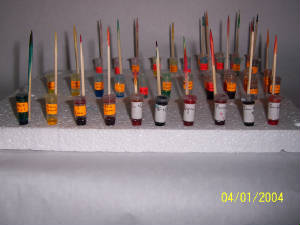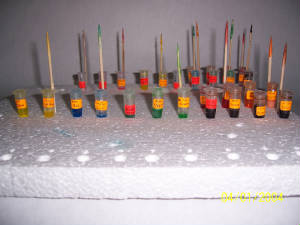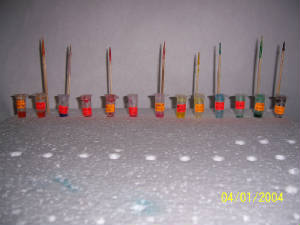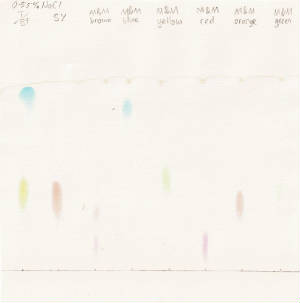|
Preparations
Standards
1) Purchase food colouring that can be obtained from grocery stalls.
Check the labels to ensure that they have the following chemicals in them:
- Brilliant Blue (BF)
- Carmoisine
(C)
- Erythrosin (E)
- Ponceau (P)
- Sunset Yellow (SY)
- Tartrazine (T)
2) Put some of the colouring into
separate containers to prevent contamination.
|

|
M&M Colouring
1) Purchase a packet of M&M and open it up.
2) Sort out the different colours
of M&M.
3) Place the same-coloured M&M's into a small beaker and add 2-3 drops of water into it.
4)
Keep stirring to extract the colouring. When the M&M colouring coat turns white, remove the M&M. Add another one and
repeat this process. Notice that if the chocolate gets extracted, the solution is considered contaminated.
5) Put about
6-10 M&M's to concetrate the solution.
6) After that, place the solution into a small container
|

|
Smarties Colouring
1) Purchase a packet of Smarties and open it up.
2) Sort out the different colours of Smarties.
3) Place the same-coloured Smarites into a small beaker and add 2-3 drops of water into it.
4) Keep stirring to extract the colouring. When the Smarties colouring coat turns white, remove the Smarties. Add another
one and repeat this process. Notice that if the chocolate gets extracted, the solution is considered contaminated.
5) Put about 8-10 Smarties to concetrate the solution.
6) After that, place the solution into a small container.
|

|
M&M Chromatography
Aim:
To investigate if the food dye used in M&M is
legal to consume and is exactly as stated in the contents.
Hypothesis:
The more soluble the food dye in this solvent, the higher the position it will appear on
the chromatography paper.
Problem Statement:
Is the food dye used in M&M legal to consume and is the contents stated exactly?
Procedure:
1) Prepare a 14x14cm chromatography paper.
2) At the bottom of the paper, measure
the height of 1.5cm and draw a straight line from the beginning of the paper until the end.
3) At the top
of the paper, use a pencil to write down the solvent that you are going to use. Then leave some
space and below it to write down the standards, the product’s name and the colour of the product.
5) Then use
the tip of a wooden splinter to dip a little bit of liquid that is in the container and start to dip those food dye orderly
on the line that is drawn on the bottom of the chromatography paper.
6) After that, put the paper in the solvent
that is prepared earlier. The chromatography paper must be vertically straight. Make sure that the solvent just touches the
bottom and must be below the food dye.
7) Leave it there until the solvent has almost reached ¾ height of the chromatography
paper. Then take it out and let it dry.
8) You can try to do more similar experiments so that you can compare the results.
After observing, start to analyze your results and write reports.

Blue colour is at the top of the chromatography paper,
followed by yellow and orange colour. Finally at the bottom of the paper is red colour.
Inference:
Blue is Brlliant Blue
Yellow is Tartrazine
Orange is Sunset Yellow
Red is Allura Red
Variables
1) Constant: Size of spot
2) Manipulated: The colour of each M&M
and type of solvent
3) Responding: Position of colours in the chromatogram
Conclusion: Brilliant
Blue is the most soluble food dye in this solvent. Allura Red is the least soluble food dye in this solvent.
Smarties Chromatography
Aim:To investigate if the food dye used in Smarties
is legal to consume and is exactly as stated in the contents.
Hypothesis:
The more soluble the food dye in this solvent, the higher the position it will appear on
the chromatography paper.
Problem Statement:
Is the food dye used in Smarties legal to consume and is the contents stated
exactly?
Procedure:
1) Prepare a 14x14cm chromatography paper.
2) At the bottom of the paper, measure
the height of 1.5cm and draw a straight line from the beginning of the paper until the end.
3) At the top
of the paper, use a pencil to write down the solvent that you are going to use. Then leave some
space and below it to write down the standards, the product’s name and the colour of the product.
5) Then use
the tip of a wooden splinter to dip a little bit of liquid that is in the container and start to dip those food dye orderly
on the line that is drawn on the bottom of the chromatography paper.
6) After that, put the paper in the solvent
that is prepared earlier. The chromatography paper must be vertically straight. Make sure that the solvent just touches the
bottom and must be below the food dye.
7) Leave it there until the solvent has almost reached ¾ height of the chromatography
paper. Then take it out and let it dry.
8) You can try to do more similar experiments so that you can compare the results.
After observing, start to analyze your results and write reports.

Blue colour is at the top of the chromatography paper, followed by yellow, orange and pink colour. Finally at
the bottom of the paper is red and purple colour.
Inference:
Blue is Brlliant Blue
Yellow is Tartrazine
Orange is Sunset Yellow
Red is Allura Red
Pink is Erythrosin
Purple is Indigo Carmine
Variables
1) Constant: Size of spot
2) Manipulated: The colour of each Smarties
and type of solvent
3) Responding: Position of colours in the chromatogram
Conclusion: Brilliant
Blue is the most soluble food dye in this solvent. Indigo Carmine is the least soluble food dye in this solvent.
|

